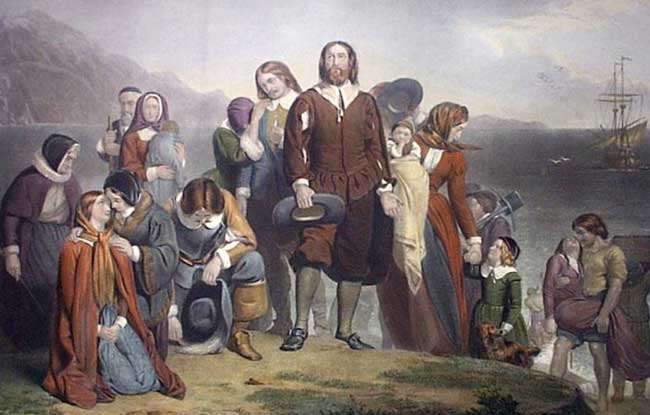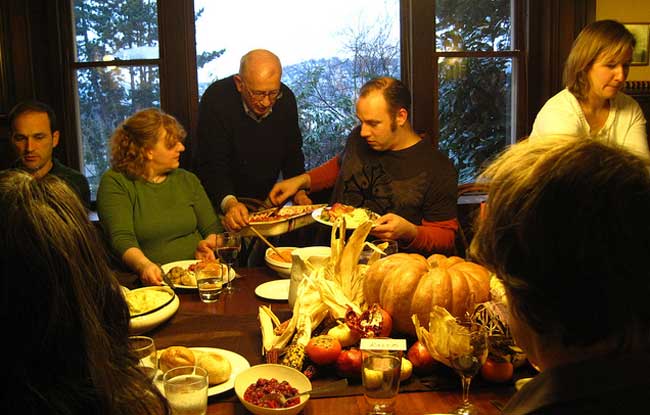In 1609, a group of Pilgrims fleeing religious persecution in England moved to Holland. They lived in Holland for a number of years until a group of English investors -- the Merchant Adventurers -- financed a trip for more than 100 passengers to the New World.
On Sept. 6, 1620, they set sail on a ship called the Mayflower, leaving from England and arriving in the New World after 65 days. They settled in a town called Plymouth in what is now Massachusetts. The Pilgrims' first winter was so harsh that fewer than 50 of the group survived the season.
These first comers established a small but stable village in Plymouth and became friendly with the Wampanoag tribe. The Wampanoags had lived in the region for nearly 12,000 years before the Plymouth colonists arrived, and their first perceptions of the Europeans weren't favorable - desperate settlers were filching supplies from the tribe's storehouses as they hunkered down for winter. The Wampanoag tribesman Squanto and an Abenaki named Samoset kindly showed them how to harvest corn and demonstrated how to fertilize their crops with fish. By March of 1621, the settlers and the Wampanoags formed an alliance and vowed to protect one another from encroaching tribes. Furthermore, the Wampanoags taught the Europeans how to live in accord with their new environment, alternately fishing, hunting and farming for sustenance as the seasons changed.
The next harvest was very successful, due in large part to help from the American Indians. The Pilgrims had enough food for the winter and had learned how to survive in the New World. Plymouth Colony's Governor, William Bradford, decided to throw a celebratory feast and invited the colony's American Indian neighbors to take part. The American Indians brought food as well, and the celebration lasted for three days.
It's unclear whether the Pilgrims themselves called that first feast a thanksgiving celebration, but they were certainly celebrating the abundance of food and the peace with their American Indian neighbours. It wasn't until several years later, after enduring a month-long drought, that Thanksgiving was celebrated in earnest. In response to the hot, dry summer months, the governor called for a feast. Soon afterward, rain revived the shrivelled crops, and the Pilgrims celebrated.
Pilgrim Myth
We generally think of the Pilgrims wearing only black-and-white clothing and buckles on their hats, clothes and shoes. In truth, buckles didn't come into fashion until later in the 17th century, and pilgrims usually wore black-and-white clothes only on Sunday. Women generally dressed in red, green, brown, violet, blue or gray, and the men wore white, beige, black, green and brown.
The custom of marking good fortune with a day of gratitude quickly caught on throughout New England. In the early days of the United States, the new nation's leaders began proclaiming country-wide thanksgiving celebrations.
Thanksgiving Dinner
While no record exists of the historic banquet’s exact menu, the Pilgrim chronicler Edward Winslow wrote in his journal that Governor Bradford sent four men on a “fowling” mission in preparation for the event, and that the Wampanoag guests arrived bearing five deer. Historians have suggested that many of the dishes were likely prepared using traditional Native American spices and cooking methods. Because the Pilgrims had no oven and the Mayflower’s sugar supply had dwindled by the fall of 1621, the meal did not feature pies, cakes or other desserts, which have become a hallmark of contemporary celebrations.
Thanksgiving Traditions
In many American households, the Thanksgiving celebration has lost much of its original religious significance; instead, it now centers on cooking and sharing a bountiful meal with family and friends. Turkey, a Thanksgiving staple so ubiquitous it has become all but synonymous with the holiday, may or may not have been on offer when the Pilgrims hosted the inaugural feast in 1621. Today, however, nearly 90 percent of Americans eat the bird - whether roasted, baked or deep-fried - on Thanksgiving, according to the National Turkey Federation. Other traditional foods include stuffing, mashed potatoes, cranberry sauce and pumpkin pie. Volunteering is a common Thanksgiving Day activity, and communities often hold food drives and host free dinners for the less fortunate.
Thanksgiving Stats
- Americans consume about 13.4 pounds of turkey each year.
- There are three U.S. cities named after turkey: Turkey, Texas, Turkey Creek, La., and Turkey, N.C.
- There are eight cities in the United States named after the cranberry.
- There are 28 places in the United States named Plymouth.
Thanksgiving is celebrated on the fourth Thursday of November. This celebration stands out from other American holidays in the sense that it isn't tied to any specific religion, and you can pretty much celebrate it however you want. The only essential traditions are to enjoy a meal with friends or family and to give thanks for what you have.
Turkey Facts
- At one time, the turkey and the bald eagle were each considered as the national symbol of America. Benjamin Franklin was one of those who argued passionately on behalf of the turkey. Franklin felt the turkey, although "vain and silly", was a better choice than the bald eagle, whom he felt was "a coward".
- Age is a determining factor in taste. Old, large males are preferable to young toms (males) as tom meat is stringy. The opposite is true for females: old hens are tougher birds.
- A turkey under sixteen weeks of age is called a fryer, while a young roaster is five to seven months old.
- Turkeys are the only breed of poultry native to the Western Hemisphere.
- Turkeys have great hearing, but no external ears. They can also see in color, and have excellent visual acuity and a wide field of vision (about 270 degrees), which makes sneaking up on them difficult. However, turkeys have a poor sense of smell (what's cooking?), but an excellent sense of taste.

Sources: history.com, tlc.com, howstuffworks.com, Wikipedia, infoplease.com
By Claudia Schalkx
Claudia is a multilingual consultant fluent in Spanish, English, Italian, and Dutch with over 25 years international experience in communications, public relations & marketing. She was born in Venezuela from Dutch parents, has lived and worked in Venezuela, Colombia, Curacao, St. Maarten, USA, Italy and The Netherlands where she resides. She is Colors Chief Editor. Her duties include content selection, revision & editing, finding and attracting collaborators, and identifying new business opportunities for Liberty Publications. More info
Pictures: Wikipedia.org // Landing of the Pilgrim Fathers by Charles Lucey // Flickr / tinaxduzgen
More Customs & Habits articles /
Do you wish to write for Colors?







